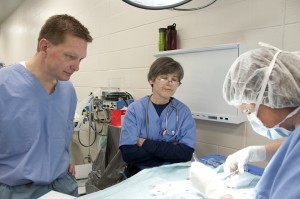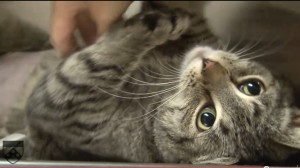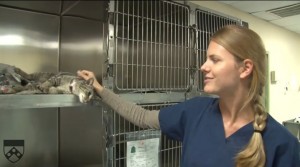Dr. Michael Moyer is a man with refreshing ideas.
“It would not take an unimaginable number of people to adopt from a shelter in order to double or triple the live exit rate for cats.”
“Clearly, we don’t want cats to be homeless and living on the streets and being victims of accidents and weather. Nevertheless, there are shelters in this country whose euthanasia rate for cats exceeds 85 percent, and I cannot imagine an outdoor environment that is 85 percent fatal to cats in the short term. If you gave me the same number of cats and we distributed them, I can’t imagine a place that I could send them that would be 85 percent fatal.”
Dr. Michael Moyer stands at the forefront of contemporary perspectives on the welfare of stray, community (or feral) and shelter cats. We first noted our admiration of his ideas and practices when we shared an article from the Philadelphia Enquirer (March 11, 2011) to our fan page. In the Enquirer article he outlined several simple steps that shelters can take to make cats more comfortable and less stressed, and therefore, healthier and more adoptable. He further noted that since entrance to a shelter is a one way trip with no live exit for most strays and homeless cats, it is not necessarily the best solution for their welfare. It may get cats off the streets but has little or no benefit for most.
Dr. Moyer describes himself as a reluctant proponent of TNR (trap neuter and release), having eventually come to the conclusion that for the most of the cats in question, life as stray or community cats is prefereble to death, the likely outcome of being put into a shelter.
He states in his blog, “This is an incredibly complicated problem, and even the success stories of TNR (Ocean Reef Club, Merrimack River) were successes with a lot of sustained effort. I can tell you that the extermination/euthanasia approach is extraordinarily expensive, does not attract a large volunteer base to sustain it, does not attract private humane philanthropy to support it, and does not invoke warm and fuzzy public relations with members of your community (upwards of 25 to 35% of community members report themselves as feeding outside cats on some sort of basis).” So, he is a pragmatic proponent of TNR, and a reasoned proponent with influential position.
Dr Moyer is Rosenthal Director of Shelter Medicine at the University of Pennsylvania School of Veterinary Medicine and represents the school in a number of local, state and national collaborative efforts with animal welfare and shelter issues. He is President-Elect and board member of the American Animal Hospital Association, and owns a veterinary hospital in PA.
“Cats are different in so many physiological and medical ways. And yet we treat them like they’re small dogs.”
It is common knowledge that cats that do not present themselves adorably or who get ill in shelters are likelier to be killed while at the shelter for perceived unadoptability or to make space for cuter, healthier specimens. According to Dr. Moyer, cats thrive when given space, and familiar scents and objects, and the stress from staying in a strange, small, clinically clean cage with no familiar objects or scents and being forced to have sitting and eating space right next to the litterbox contributes to withdrawal and antisocial behavior, as well as illness; thus setting cats up for unadoptability and possibly death.
“There’s no shortage of cats, so there’s usually little hope for an asocial, frightened cat in a shelter, even though these animals might be capable of friendly, affectionate behavior under better conditions.”
For further exploration of his observation and positions we’ll let Dr. Moyer continue to speak for himself, as he does in this staff Q&A conducted with Greg Johnson for the Penn Current.
Q. Where does the disparity between dogs and cats in the ACCT Center come from?
A. Cats are more successful living as a free-roaming animal. They’re well-adapted to surviving in those circumstances. We are culturally accustomed to seeing cats outside. It doesn’t startle us if we walk by somebody’s house and there is a cat sitting on the porch or in the alley. Whereas if we saw a dog running loose without an owner nearby, we would think that something was wrong.
Q. How important is adoption in helping to solve the city’s cat problem?
A. Community adoption is the part that could most easily change the dynamic. It would not take an unimaginable number of people to adopt from a shelter in order to double or triple the live exit rate for cats. We know that there are at least as many people looking for cats as there are cats entering shelters, but it’s a distribution and supply mismatch. The supply is in one zip code in North Philadelphia and the people looking for cats are all over the Greater Philadelphia Region.
Q. You mentioned that shelters can be very stressful for cats, much more so than dogs. Why don’t cats do well in shelters?
A. I think they’re much more neophobic, fear of new things, than dogs in general. We also tend to house them inadequately because we have designed cages that merely contain, but do not adequately house cats. The space requirements, for example, have been grossly underestimated. One of the best correlations with health in a shelter is the amount of square footage that the cats have. If they have an adequate sized cage, then their rates of disease drop significantly.
Q. You told the Philadelphia Daily News that you used to think that cats were better off in shelters than out in the elements, but you have since changed your mind. It sounds like shelters are so bad for cats that they are better off out in the street.
A. If we look at the risk for death entering a shelter at a certain time of year—and it’s going to vary based on the shelter because some shelters have more success at placing cats than others—I think each shelter needs to look at what it’s providing cats in terms of husbandry, cage space and an opportunity to leave by way of adoption. They have to look at all those and decide whether that’s a better outlook than a cat surviving on its own outside, which is clearly less than ideal. Clearly, we don’t want cats to be homeless and living on the streets and being victims of accidents and weather. Nevertheless, there are shelters in this country whose euthanasia rate for cats exceeds 85 percent, and I cannot imagine an outdoor environment that is 85 percent fatal to cats in the short term. If you gave me the same number of cats and we distributed them, I can’t imagine a place that I could send them that would be 85 percent fatal. That sounds really harsh and I don’t mean to pin the blame on the shelters. It is the nature of this gigantic influx of cats that exhausts and depletes all shelter resources during cat season, which is March or April through September.
Q. There are a lot of flyers for lost cats in West Philadelphia. Do you have any advice for people who have lost a cat?
A. It’s interesting because my students ask about this. If you’re living in West Philadelphia and you lost a cat, where would you look for it? You’d put up posters; you’d call around. Would it occur to you that your cat could be in North Philadelphia? It’s not obvious that your cat would be there, so I think people need to call animal control and report their cat. They will be told to visit the shelter daily to look for their cat because there is no adequate way to describe a cat. If your cat is an orange tabby, I bet there are 15 orange tabby cats in that shelter right now. There are about 250 to 300 cats in the shelter at this time of year and it’s very hard to adequately describe them by any criteria. Even the best photograph is not going to be good enough to reliably identify your cat, so they’re going to advise you to go and take a look. I certainly like the idea of advertising locally with posters, letting people in the neighborhood know.
One of the simplest ways to get your cat back is to have a collar with ID on it and add to that a microchip. They scan for microchips at all shelters. The owner reclaim rate for cats is dismal. It’s .6 percent in Philadelphia.
Q. Are you a cat person or a dog person?
A. My bias in terms of interaction has always been towards dogs, but I have both. And I think cats are smarter.
In the following video Dr. Moyer puts out a pitch for adopting shelter cats.
Led by Dr. Moyer, Penn Vet’s Shelter Animal Medicine Program takes fourth-year Vet School students into area shelters to provide spay and neutering services for both dogs and cats. Penn Vet is working to eliminate the unnecessary killing of potentially adoptable animals in Philadelphia with the highly successful spay/neuter component of Penn Vet’s Shelter Animal Medicine Program.
The Shelter Animal Medicine Program is designed to ensure that students experience other important shelter issues and topics, including homeless animal management, the role of the veterinarian in an animal shelter, pet animal overpopulation, forensic medicine, infectious disease control, behavior problems and evaluations, wellness and animal cruelty, neglect and hoarding.
We feel hopeful for the future welfare of stray and homeless cats, and lost cats who end up at shelters, with Dr. Moyer setting the example for a new generation of caregivers and policy makers.



